Linux File Permissions Chmod
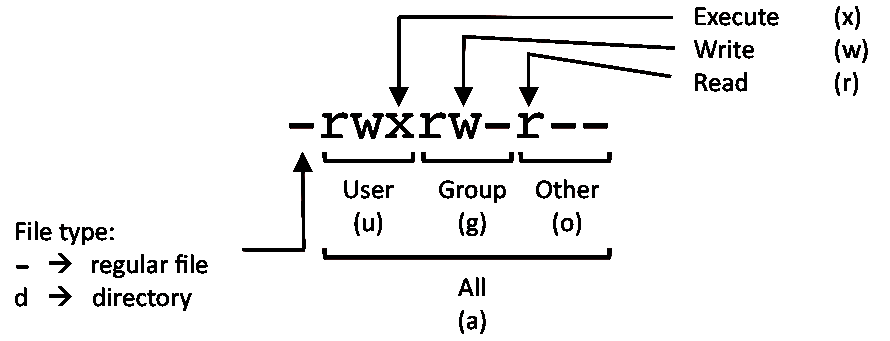
Linux Command Cheat Sheet

Unix Permissions

Pin By Dr Stefan Gruenwald On Cheatsheets Computer Science Programming Learn Javascript Linux Operating System

How Did The Number 777 In Chmod 777 Come Out Under Linux Laptrinhx

Understanding File Permissions

Chmod File Permissions In Linux Unix
Chmod (this Tutorial's subject) and chown are designed to be able to change the defaults of user access as part of a secure plan by the Administrator, as well as, in the case of chown, modifying downloaded files to make them executable.
Linux file permissions chmod. The chmod command is used to alter the permissions of a file. Apart from this, there are also some “access right flags.”. In Linux, you can easily change the file permissions by right-clicking the file or folder and select “Properties”.
The owner of a file can change the permissions for user (u), group (g), or others (o) by adding (+) or subtracting (-) the read, write, and execute permissions. This only changes the permissions for the owner of the file. Chmod Modifies File Permissions.
Chmod is used to make changes:. The chmod command, like other commands, can be executed from the command line or through a script file. Further, the ownership of files also depends on the uid (user ID) and the gid (group ID) of the creator, as discussed in this.
Bash, Shell, Terminal, Command Line cheat sheets linux Ubuntu. Once you have the file permissions in absolute or symbolic mode, you can use the chmod command to change the file permission. Recursive chmod using find, pipemill, and sudo.
The name speaks for itself. To see the permission settings for a file, we can use the. Check Permissions using GUI Finding the file (directory) permission via the graphical user interface is simple.
After changing a directory's mode to 664 the folder's mode will be. How to Use chmod Command. Permissions used to be called mode of access and hence chmod was the short form of change the mode of access.
Rights can be assigned to read a file, to write a file, and to execute a file (i.e., run the file as a program). It may be used to add or remove permissions symbolically. The chmod command allows you to change the permissions of files using symbolic or numeric mode.
You can configure your file permissions inside of your Windows drives using the mount options in wsl. Linux File Permission :. Chmod never changes the permissions of symbolic links;.
Mykyta Dolmatov / Getty Images. There are two options to choose from, depending on your personal preference:. After changing a file's mode to 664 the file's mode will be displayed in Unix style file lsting as:.
As you become familiar with the chmod command, try using the -v option for a verbose response as in the following example:. Simply enter this line:. There are two basic ways of using chmod to change file permissions:.
In a previous article, we looked at how to manage file & directory ownership using the chown. In Linux, who can do what to a file or directory is controlled through sets of permissions. Chmod command in Linux is used to change or assign permissions on files and directories.
When you wish to set the mode of a file (set the permissions) you use the UNIX command chmod at the system prompt. In linux terminal, to see all the permissions to different files, type ls -l command which lists the files in the working directory in long format. Chmod -wx filename to take out write and executable permissions.
For a directory, whoever has `read'. Users can simply modify file permissions using the chmod (change mode) command. Change file permissions in Linux.
Understand how Ubuntu / Linux file permissions and special mode bits work. View (u)ser, (g)roup and (o)thers permissions for chmod 766 (chmod a+rwx,g-x,o-x) or use free online chmod calculator to modify permissions easily. Chmod -R MODE DIRECTORY.
Learn how to change these permissions using the chmod command. The chmod command changes the access permissions of files and folders. This is not a prob‐ lem since the permissions of symbolic links are never used.
The commands for modifying file permissions and ownership are:. % chmod -v 640 myfile.txt mode of `myfile.txt' changed to 0640 (rw-r-----). The chown command stands for “change owner”, and allows changing the owner of a given file or folder, which can be a user and a group.
In Unix and Unix-like operating systems, chmod is the command and system call which is used to change the access permissions of file system objects (files and directories).It is also used to change special mode flags. File permission can be represented in a symbolic or numeric (octal) format. Chmod – change permissions.
On Unix-like operating systems, a set of flags associated with each file determines who can access that file, and how they can access it. Select the permissions you require below. For example, to add execute permissions for the owner of a file you would run:.
Chmod 755 -R /opt/lampp/htdocs will recursively set the permissions. To determine the mode (or permission settings) of a particular file, use the command `ls -lg filename'. The easiest way for a beginner to modify file or directory permissions is to use the symbolic mode.
Change permission on all the files in a directory recursively. It is important, however, that you understand the only user that can actually modify the permissions or ownership of a file is either the current owner or. Let’s say we want to change Linux file permissions from -rwxrw-rw-to -rwx-r–r–.
The permissions control the actions that can be performed on the file or directory. One set for the owner of the file, another set for the members of the file’s group, and a final set for everyone else. How to Set File Permissions Using `chmod' Files.
By now, you should have a working understanding of file permissions, file ownership, and how to change the file permissions for the different user groups. If you need to change a file permission, use the chmod command. As explained in the article Permissions in Linux, Linux uses a combination of bits to store the permissions of a file.We can change the permissions using the chmod command, which essentially changes the ‘r’, ‘w’ and ‘x’ characters associated with the file.
Checking through the graphical interface or using the command. Running chmod 770 on project-a gives us the permission set we want:. Linux File Permissions, chmod, & umask.
Find out how default permissions for new files are configured via a user's umask value. To recursively operate on all files and directories under a given directory, use the chmod command with the -R, (--recursive) option. Neither command is difficult to use.
There are three sets of permissions. Linux can also be used in mainframes and servers without any modifications. The highly productive Linux system offers various levels of permission to ensure that the user has enough ways to interact with files and directories.
There are two ways to use chmod — the symbolic mode and the absolute mode. Read The read permission allows an associated user to open and read a file or list the files in a directory. To start with file permissions, you have to find the current Linux permission settings.
How To Change File Permissions In Linux Using ‘chmod’ Command. Chmod is a great Linux command for manipulating file and directory permissions. Multi-user systems, such as Linux, require setting up and managing file permissions that ensure only authorized users have access to files they are supposed to.
Note that “r” is for read, “w” is for write, and “x” is for execute. Each file on the Linux systems bears a set of permissions. File Permissions in Linux/Unix with Example Linux is a clone of UNIX, the multi-user operating system which can be accessed by many users simultaneously.
Each class can have read, write and execute permissions. Actually, chmod Command in Linux plays a greater role to keep all the files and directories of the system safe and secure so that no unauthorized person. Give read, write and execute permission to the file’s owner, read permissions to the file’s group and no permissions to all other users:.
There are 3 permission types that are associated with a file. Rwxrwx--- How does 770 correspond to rwxrwx---?. There's no way to set the permissions for files automatically in only this directory that are created after you set the permissions, but you could change your system-wide default file permissions with by setting umask 022.
On a Linux system, each file and directory is assigned access rights for the owner of the file, the members of a group of related users, and everybody else. Add the file’s owner permissions to the permissions that the members of the file’s group have:. View (u)ser, (g)roup and (o)thers permissions for chmod 664 (chmod a+rwx,u-x,g-x,o-wx) or use free online chmod calculator to modify permissions easily.
File permissions in Linux file system are managed in three distinct user classes:. Refer to these chmod command examples if you are not familiar with this command. You can use chmod command for changing the permissions on a file in Linux.
The first number represents the Owner permission;. Chmod +rwx filename to add permissions. Some details about the user, group and other you may need to know to clear your basics.
In Linux, files and directories are treated similarly. There are two ways to use the chmod command:. Use sudo, the find command, and a pipemill to chmod as in the following examples.
To assign reasonably secure permissions to files and folders/directories, it's common to give files a permission of 644, and directories a 755 permission, since chmod -R assigns to both. Read permissions identified by ‘r‘ Write permissions identified by ‘w‘ Execute permissions identified by ‘x‘ To check the file permissions of any file, use the ls command and the -l option. Read, Write, and Execute.
9 Comments Originally posted October 13, 14. Myfile.txt – the name of the file/folder. Chmod 744 file name By executing this command, the owner can read, write, and execute the file (rwx).
However, group and others are only allowed to read (r–). Any files created, modified, or accessed in the Linux root file system follow standard Linux conventions, such as applying the umask to a newly created file. There will be a Permission tab where you can change the file permissions.
Chmod is a command in Linux and other Unix-like operating systems that allows to ch ange the permissions (or access mod e) of a file or directory. The chmod system call cannot change their permissions. The permission scheme described above also applies to directories.
First, we will discuss the three types of permissions in Linux:. The second represents the Group permissions;. Set the permissions for a file or directory by using the chmod command.
How‐ ever, for each symbolic link listed on the command line, chmod changes the permissions of the pointed-to file. In the terminal, the command to use to change file permission is chmod. To change directory permissions in Linux, use the following:.
Write The write permission allows an associated user to modify the contents of a file or add, remove, and rename files in a directory. To change the file or the directory permissions, you use the chmod (change mode) command. $ sudo chmod <specify the file permissions> <specify the file/directory name> Special Permissions.
But this raises security concerns as an unsolicited or malign user can corrupt, change or remove crucial data. The main difference between access rights for files and directories is that the x permission on a file grants permission to execute it, where on a directory, it grants permission to enter it. Chmod Command in Linux Linux File Permission Introduction to Linux File Permission.
The tool will provide you with an octal code that corresponds to these permissions which can then be applied to relevant directories and files with chmod. The general syntax to recursively change the file’s permissions is as follows:. A sample permission string would be chmod 640 file1, which means that the owner has read and write permissions, the group has read permissions, and all other user have no rights to the file.
The chmod command stands for “change mode”, and allows changing permissions of files and folders, also known as “modes” in UNIX. Accessing files in the Linux root file system from Linux. Transferring Ownership with chown.
And the last number represents the permissions for all other. In Linux / Unix systems, accessibility to files and directories is determined by file ownership and permissions. Just select the appropriate permissions and it will tell you the permissions in both absolute and symbolic mode.
Adding the numbers in each section results in permissions of 664. User/owner, group and others/public. To change file and directory permissions, use the command chmod (change mode).
Types of permissions which we will be changing using chmod command :. Using chmod in Symbolic Mode. The request is filtered by the umask.The name is an abbreviation of change mode.
To meet our goal, we will run:. Linux file permission is a very important aspects in terms of security issues for the system administrator of Linux Operating System. Chmod -rwx directoryname to remove permissions.
With the concepts mentioned in this article, you are equipped with sufficient knowledge to handle permissions in Linux-based distros. If you want an easy way to know the Linux file permission in numeric or symbolic mode, you can use this chmod calculator. Each of the three digits in our chmod statement — 7, 7, 0 — corresponds to Owner, Group, and Others rights.
X Permission to execute the file, or, in the case of a directory, search it. If you need to list a file's permissions, use the ls command. Add a sticky bit to a given directory:.
Each row has 2 examples, one for setting that permission for a file, and one for a directory named ‘dir’.
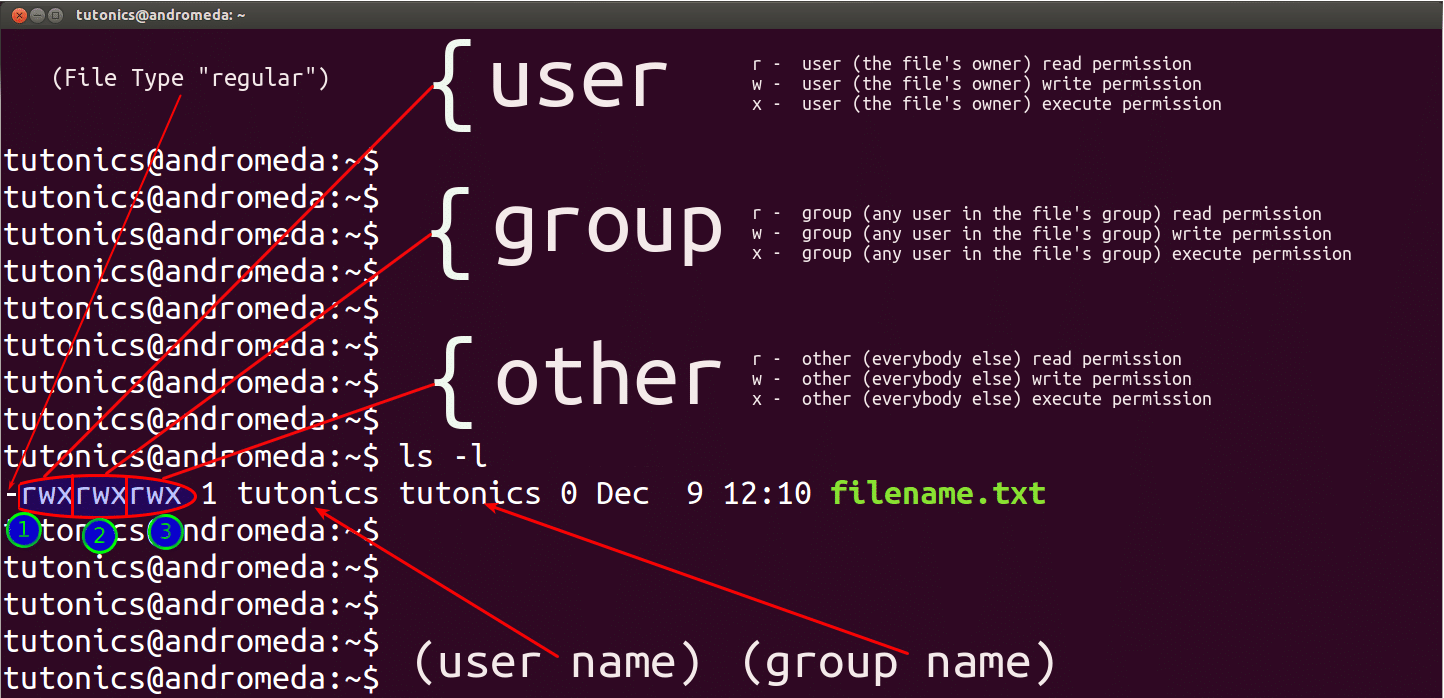
Linux File Permissions Tutorial For Beginners

How To Use Linux File Permissions And Ownership On Alibaba Cloud Ecs Dzone Open Source

Learning The Shell Lesson 9 Permissions

Chmod 777 What Does This Mean Learn Linux Permissions Easy Way

Chmod Cheatsheet Linux

Linux Chapter 3 Permission Management Commands Change File Permissions Chmod 777 Root A Programmer Sought

Chmod Archives Yet Another Linux Blog

Linux File Permissions Tutorial How To View And Change Permission
Q Tbn 3aand9gcr2lfpzbutqythmvbwafnxvyggqfj7hnw6fhh Kcozkk8m5 V7o Usqp Cau

Chmod Command In Linux File Permissions Designlinux
Q Tbn 3aand9gcs Trmaopb41lzfo2wl Mi6olorurkywaddbudhnw Ne1mor3ct Usqp Cau

Understanding Linux File Permissions With Chmod Umask Chown And Chgrp Liquidon Net

Modify File Permissions With Chmod Linode

File Permissions In Linux Unix With Example

Chmod 777 What Does It Really Mean Make Tech Easier

Chmod 777 What Does It Really Mean Make Tech Easier
Your Own Linux Chmod Basics Of Files Directories Permissions And Use Of Chmod

Linux Chmod Command Linuxfordevices
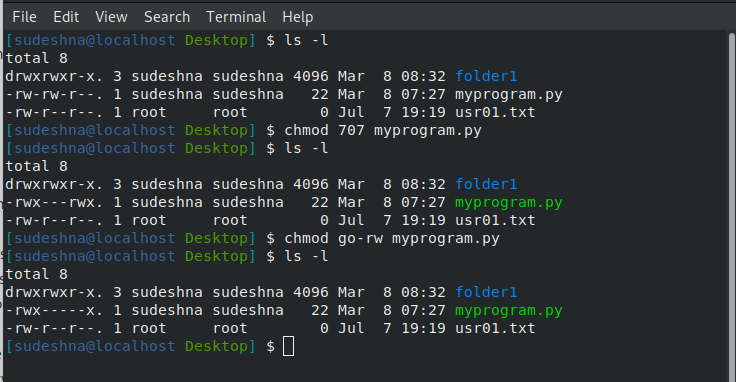
File Permissions In Linux Dzone Open Source

Linux File Permission Change By Chmod Command In Linux Guide For Beginners
Q Tbn 3aand9gcrjnvlxj0s Bjlyqdmcffgnaicqwuoecwomv8yezuw Usqp Cau

Chmod All Directories Permissions Only And Omit Files Recursively On Linux Howto Walking In Light With Christ Faith Computing Diary Walking In Light With Christ Faith Computing Diary

Change File Permissions Easily With Online Chmod Calculator By Chmodcalcu Issuu

Understanding File Permissions 2buntu

How To Change Directory Permissions In Linux Pluralsight

Changing File Permissions In Linux The Chmod Command By Saswat Subhajyoti Mallick Medium

08 Unix Linux Shell File Directories Permission Chmod Command Youtube

Csc128 Permissions And Links Chmod And Ls

Linux Permissions Guide Plex Support

Linux File Permission Javatpoint

What Is Chmod 777

Understanding Basic File Permissions And Ownership In Linux The Geek Diary

Deciphering Linux File System Permissions Pressidium Managed Wordpress Hosting

How To Change Directory Permissions In Linux Pluralsight

What Is Chmod How To Use Chmod For Wordpress File Permissions

Chmod Command In Linux File Permissions Kirelos Blog

Chmod Recursive Change Permissions Recursively On Files Folders

Permissions In Linux Geeksforgeeks
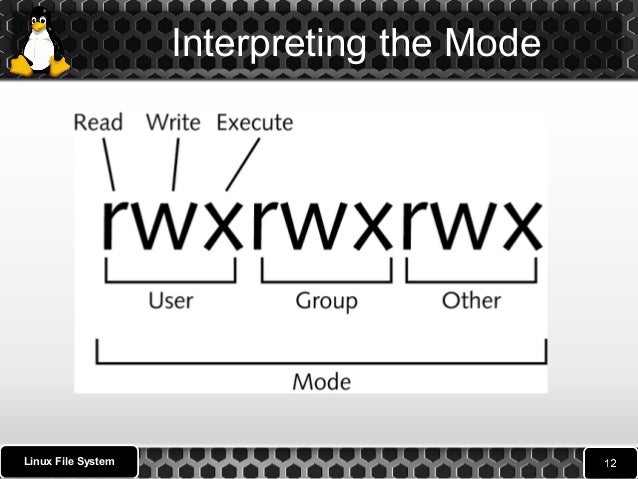
Write Access Chmod Syntax

Linux Users And Groups Linode

Unix File Permissions Computer Science
Video Linux File Permissions Chmod And Chown Linux Org

Chmod Options Permissions Files Linux Pocket Guide Book

Linux Permissions An Introduction To Chmod Enable Sysadmin

An Introduction To Linux File Permissions Boolean World

Linux Commands 5 File Permission Chmod Youtube
Q Tbn 3aand9gcq1nsq3kxri7ryrifobs2rfobawbv4hezfw9 Ldf4feblahyn09 Usqp Cau

How To Use The Chmod Command On Linux

Linux File Permissions Know The Reason Behind That Chmod 777 By Abhishek Chandra Medium

Chmod 777 In Terminal The Command To Make All Changes Affect Every File And Folder Ask Ubuntu

How To Use Chmod Command In Linux Explained With Examples
.png)
File Permissions In Linux Unix With Example
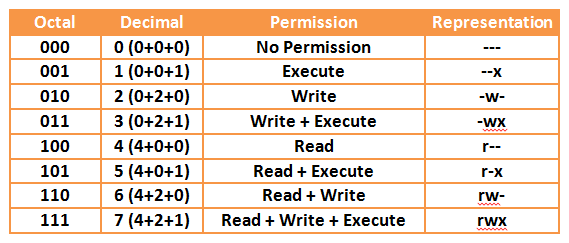
Your Own Linux Chmod Basics Of Files Directories Permissions And Use Of Chmod

How To Change Permissions Chmod Of A File Hostgator Support

Understanding File Permissions And Access Rights In Linux Linux Stall
/i7guGwCYcn-34e068e148ae4e918b29c86cd2d5740e.png)
Configuring Unix Linux File And Directory Access Rights

Understanding Linux Permissions And Chmod Usage
Linux Chmod Tips

Linux File Permissions Chmod Umask Tutonics

Understanding Linux Permissions And Chmod Usage

How To Use The Chmod Command On Linux

11 Popular Unix Linux Chmod Command Examples To Change File Permissions Cyberithub

Change File Permissions Recursively Linux Linux Hint

A Unix And Linux Permissions Primer Daniel Miessler

Chmod 777 A Definitive Guide To File Permissions

Linux File Permissions Complete Guide Devconnected

Chmod Wiki Ask Ubuntu

Chmod Command In Linux With Examples Geeksforgeeks

Permissions In Linux Geeksforgeeks

Unix Linux Os X File Permissions

Ppt Agenda Powerpoint Presentation Free Download Id

Linux Chmod Example Linux Hint
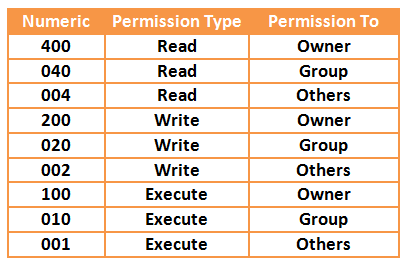
Your Own Linux Chmod Basics Of Files Directories Permissions And Use Of Chmod

How Do Linux File Permissions Work

Understand Linux File Permissions Using Chmod And Chown Commands Programming Tips For Versatile Coders

Linux Unix Permissions And Attributes Linuxsecrets

How To Deny File Permissions To Everyone Except Yourself In Linux Linuxhostsupport

Linux Concepts File Directory Permissions Hari S Technical Space

File Security

An Introduction To Linux File Permissions Boolean World

Chmod 777 755 655 644 And More Permissions Linux Files Tutorials

Linux File Permissions Complete Guide Devconnected

Chmod Command In Linux File Permissions
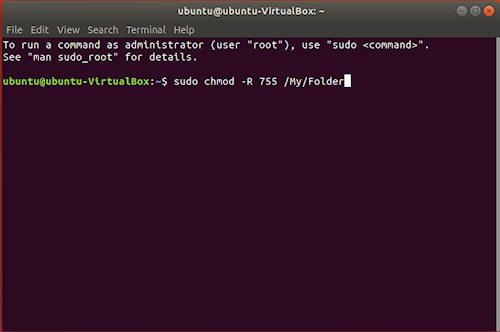
Introduction To Linux File Permissions Attributes Chmod Globo Tech

Linux Admin 101 File Permissions With Chmod Chgrp And Chown Trash Computer

What Is Chmod 777 How To Change File Permissions For Linux Tech Ninja Pro

9 Quick Chmod Command Examples In Linux

Chmod Wikipedia
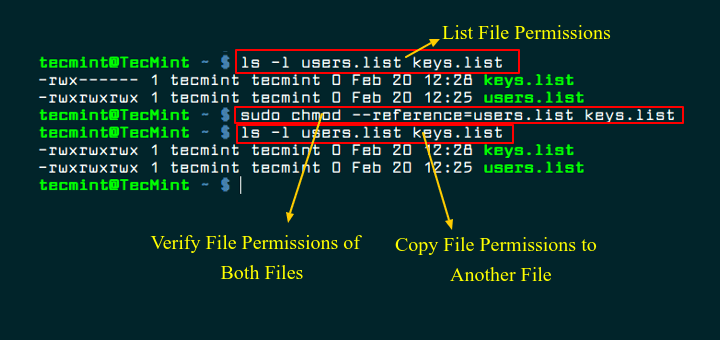
How To Copy File Permissions And Ownership To Another File In Linux

File Permissions In Linux Unix With Example

Linux File Permissions And Chmod Doug Vitale Tech Blog

How To Change File Permissions Recursively With Chmod In Linux

Linux Terminal File Permissions Chmod Chown And Chgrp Linux Line Tools Thing 1

Linux Chmod Command Linuxfordevices

How To Change Directory Permissions In Linux Pluralsight

How To Set And Manage File Permission In Linux Part 1

How To Change File Permissions Recursively With Chmod In Linux

Explain Absolute And Relative Permission Using Chmod Linuxteach



